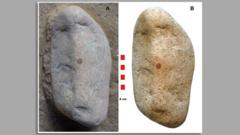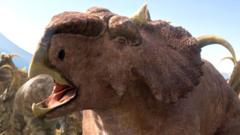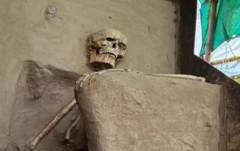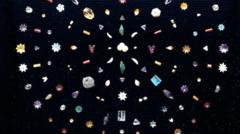Archaeologists have discovered a luxurious private bathhouse in Pompeii, along with the skeletons of two victims of the AD79 eruption, offering a glimpse into the lives of the wealthy and the hardships faced by the lower classes during the disaster.**
Unearthing the Luxury of Pompeii: A Historic Bathhouse Discovery**
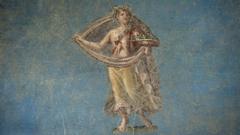
Unearthing the Luxury of Pompeii: A Historic Bathhouse Discovery**
A stunning find in Pompeii reveals a lavish bathhouse, marking a significant archaeological milestone and providing insight into ancient Roman life and its societal contrasts.**
In a remarkable archaeological breakthrough, a private bathhouse, believed to be the largest of its kind found in the ancient city of Pompeii, has been uncovered after being hidden under layers of volcanic debris for nearly 2,000 years. This discovery comes amidst ongoing excavations in the site, revealing the opulence of Roman life before the catastrophic eruption of Mount Vesuvius in AD79.
Dr. Gabriel Zuchtriegel, director of the Archaeological Park of Pompeii, speaks of the almost instantaneous connection to the past: "It’s almost as if the people had only left a minute ago." The luxurious bath complex, featuring hot, warm, and cold rooms, intricate mosaics, and a sizable plunge pool, exemplifies the high living standards of the elite in that era. “There are just a few houses that have a private bath complex, so it was something really for the wealthiest of the wealthy,” Dr. Zuchtriegel remarked, emphasizing its significance.
Analysis of two skeletons found within the premises sheds a haunting light on the final moments of these individuals—the woman, aged 35 to 50, was discovered clutching jewelry and coins, alongside a younger man in his late teens or early 20s. Their tragic fate unfolded in a small room where they attempted to hide from the volcanic eruption but ultimately fell victim to a devastating pyroclastic flow. “This is a dramatic place, and everything you find here tells you about the drama," noted Dr. Ludovica Alesse, a Pompeii conservator.
Despite a third of Pompeii still lying under the volcanic rubble, this extensive excavation effort is yielding rich insights into daily life and the stark contrasts between social classes. While the luxurious bathhouse and other facilities such as a bakery and laundry reflect the grandeur of the elite, the discovery of their last moments, recovered along with various artifacts, reveals the dire circumstances faced by many during the eruption.
Among the newly uncovered features, archaeologists found detailed murals and functional spaces indicative of the daily activities in ancient Roman society. The bathhouse itself, adorned with vibrant colors and frescoes, would have provided a social hub for the wealthy, allowing for relaxation and communal interaction.
Not far from the lavish amenities, the more austere conditions of slaves are highlighted by findings in the adjacent boiler room, emphasizing the exploitation that sustained such luxury. "The most powerful thing from these excavations is that stark contrast between the lives of the slaves and the very, very rich," Dr. Sophie Hay emphasized.
As excavations approach completion, archaeologist Dr. Anna Onesti remarked on the wonders yet to be discovered, expressing excitement about unearthing artifacts each day. This find notably propels the narrative of Pompeii into a new light, revealing not only the splendor of its elite but also the tragic tales of those who were left behind.
For viewers keen on exploring these discoveries further, the BBC is set to air a documentary series titled "Pompeii: The New Dig," showcasing the ongoing excavation and its historical significance. Discoveries of this magnitude stand as crucial links to the past, illustrating the duality of life in ancient Rome amid a looming disaster.
Dr. Gabriel Zuchtriegel, director of the Archaeological Park of Pompeii, speaks of the almost instantaneous connection to the past: "It’s almost as if the people had only left a minute ago." The luxurious bath complex, featuring hot, warm, and cold rooms, intricate mosaics, and a sizable plunge pool, exemplifies the high living standards of the elite in that era. “There are just a few houses that have a private bath complex, so it was something really for the wealthiest of the wealthy,” Dr. Zuchtriegel remarked, emphasizing its significance.
Analysis of two skeletons found within the premises sheds a haunting light on the final moments of these individuals—the woman, aged 35 to 50, was discovered clutching jewelry and coins, alongside a younger man in his late teens or early 20s. Their tragic fate unfolded in a small room where they attempted to hide from the volcanic eruption but ultimately fell victim to a devastating pyroclastic flow. “This is a dramatic place, and everything you find here tells you about the drama," noted Dr. Ludovica Alesse, a Pompeii conservator.
Despite a third of Pompeii still lying under the volcanic rubble, this extensive excavation effort is yielding rich insights into daily life and the stark contrasts between social classes. While the luxurious bathhouse and other facilities such as a bakery and laundry reflect the grandeur of the elite, the discovery of their last moments, recovered along with various artifacts, reveals the dire circumstances faced by many during the eruption.
Among the newly uncovered features, archaeologists found detailed murals and functional spaces indicative of the daily activities in ancient Roman society. The bathhouse itself, adorned with vibrant colors and frescoes, would have provided a social hub for the wealthy, allowing for relaxation and communal interaction.
Not far from the lavish amenities, the more austere conditions of slaves are highlighted by findings in the adjacent boiler room, emphasizing the exploitation that sustained such luxury. "The most powerful thing from these excavations is that stark contrast between the lives of the slaves and the very, very rich," Dr. Sophie Hay emphasized.
As excavations approach completion, archaeologist Dr. Anna Onesti remarked on the wonders yet to be discovered, expressing excitement about unearthing artifacts each day. This find notably propels the narrative of Pompeii into a new light, revealing not only the splendor of its elite but also the tragic tales of those who were left behind.
For viewers keen on exploring these discoveries further, the BBC is set to air a documentary series titled "Pompeii: The New Dig," showcasing the ongoing excavation and its historical significance. Discoveries of this magnitude stand as crucial links to the past, illustrating the duality of life in ancient Rome amid a looming disaster.


